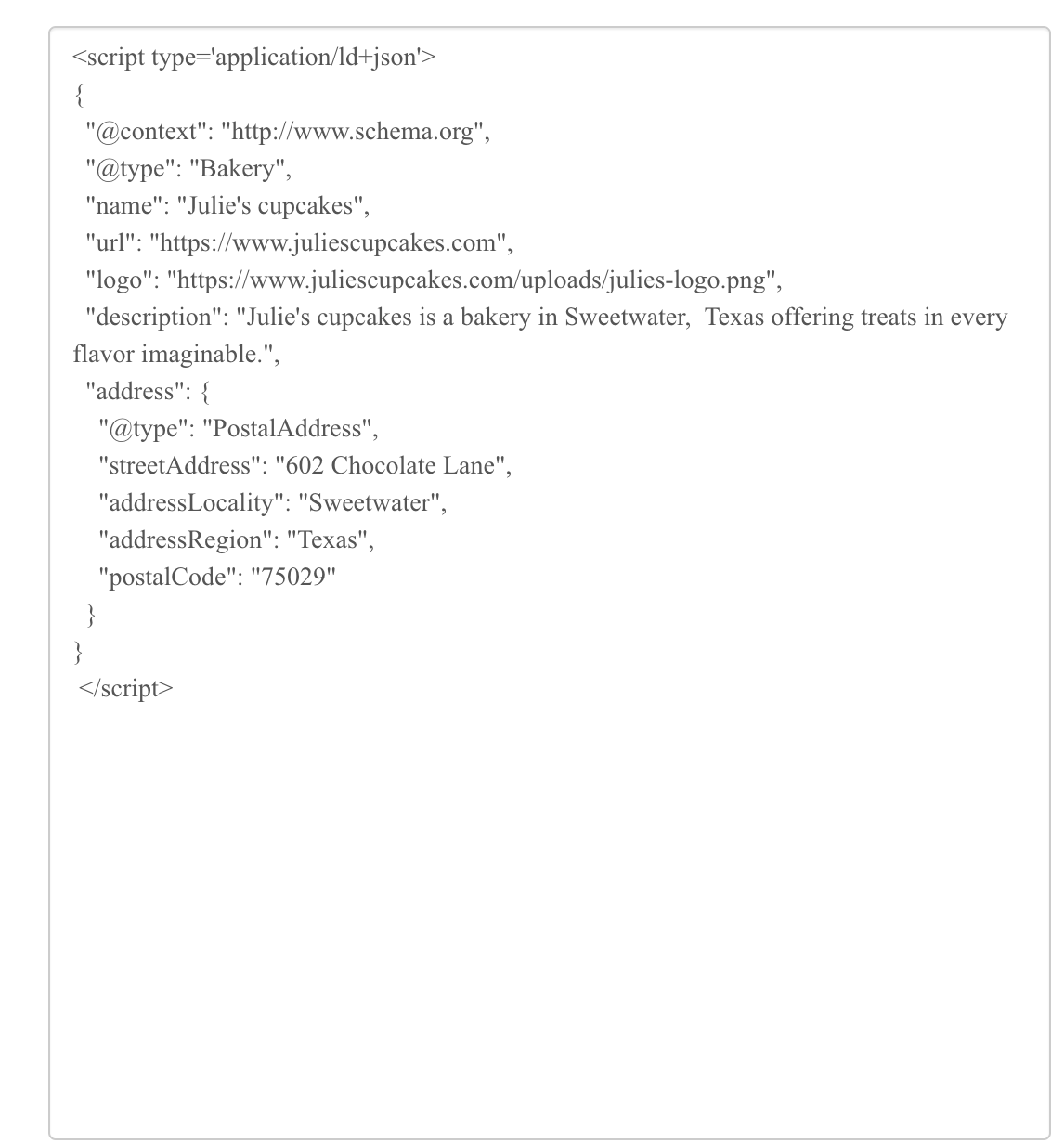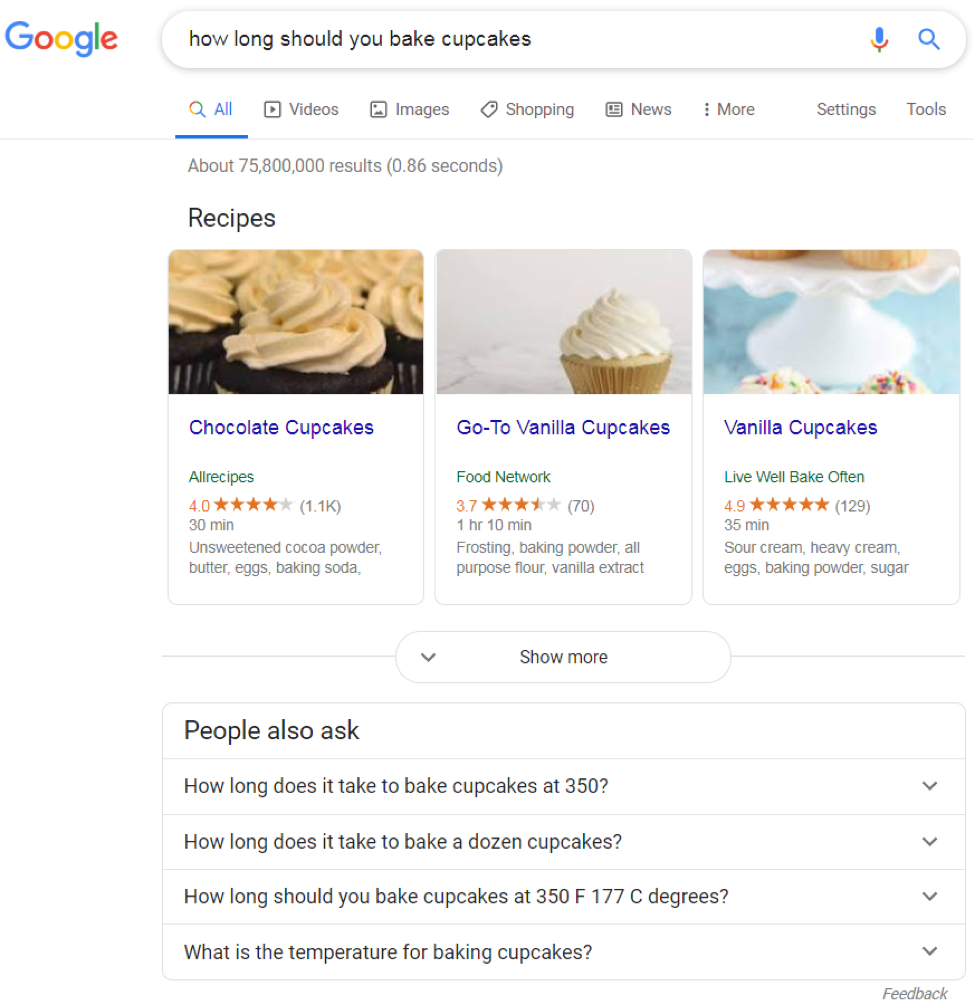
This finding may seem apocalyptic to some marketers. After all, how will people convert if they never visit your website to begin with? While living in a zero-click world isn’t ideal, it also isn’t the end of SEO. Below you’ll find three strategies to use to still give your business the visibility (and conversions) it needs without getting a click.
Be the Rich Snippet Google Wants to See in the World
In 2011, schema was created by Google, Microsoft, Yahoo and Yandex as a vocabulary used by developers that would allow website content to be better understood by the search engines. For example, if you had an address on your website without schema, you would have to hope Google understood that the numbers and words on your contact page were an address. With schema however, you’re producing the code equivalent of a red flashing sign – “In case you didn’t know this was my address, I’m here to tell you it is!” So, while a lack of schema doesn’t prevent Google and other search engines from understanding what you’ve written, it does help. After all, who doesn’t love red flashing signs?
Example of Schema Markup:

Not only does schema help Google understand your content, it can also help Google show your content in rich results. Rich results (also called rich snippets or featured snippets) are results that appear near the top of the search engine results page, giving the user a preview of what they would see on a webpage without that user having to go to your website.
Example of Rich Results:

Google can still show your websites in rich results without schema and can choose not to show your website in rich results even with schema. Given that the appearance of these features is up to Google’s discretion, we use schema because Google says it “can help your site display in richer features in search results,” and we want to help Google show our client’s products any way we can.
Some SEO experts refuse to place structured data on their website because appearing in a rich snippet could prevent users from clicking through to your website. However, the times they are a-changin’, and if you don’t appear in a rich result, someone else will.
Better Understand Your Organic Health
In a zero-click world, it will be more difficult to judge your SEO success with traditional metrics, such as sessions and users. You’ll soon start to lean on other metrics to judge your overall organic health. The first metric we recommend tracking is impressions, or how many times you appeared on Google. This is being tracked by default if you’ve set up Google Search Console, but data only goes back 16 months, which can make year-over-year comparisons difficult.
For local businesses who want to track the number of times they appear on Google, we recommend setting up Google My Business. Google My Business is Google’s local listing management tool that helps owners control what customers see about a business on Google search results pages. This tool also features reporting on how many times your local listing (not your website) appeared in search, whether someone was looking for your business by name or was searching for your general topic, and whether someone saw you on Google Maps or Google Search.
The next metric we recommend tracking is overall search position for a term. Technically this can be reported in Google Search Console; however we don’t recommend this. While Google insists this data is accurate, studies have shown that reporting on ranking through Google Search Console is more inaccurate than other Google Search Console metrics. Therefore, we recommend looking into rank tracking software such as SEMRush or Mozto understand how your ranking is fluctuating. This will give you a better idea if your loss in sessions is due to a loss of visibility among competitors or if users are simply finding what they’re looking for via rich results.
Third-party ranking tools come with other bonuses too. In addition to tracking your ranking, you can track the search engine results features for which your keywords are showing up. Due to the fact that there are so many types of rich results – such as reviews, FAQs, videos, events, recipes, and “people also ask” – not knowing what specific rich result you’re losing clicks and visibility to can make optimizing your website a little like driving without headlights on. For example, if the search term “how to use my easy bake oven” shows a video as the number one spot rather than a text listing, you know that you need to shift your SEO strategy to create a better video rather than focusing on adding text to a page on your website.
Change the Definition of Success and How to Attribute It
Much like the suggestion above, in azero-click world we have to think differently about what business KPIs we use to measure marketing success. If Google is making it harder for users to visit our website, and as a result fill out a form, what is Google making easier for users? For local businesses, this may be as simple as diving into your Google My Business dashboard.
The Google My Business dashboard reports on a number of things, but two of the top business metrics to focus on in a zero-click world are phone calls and the number of times someone gets directions to your business. Additionally, if you have someone responding to messages throughout the day in real time, you can consider enabling Google My Business’s chat feature.
While you’re considering how to change your measurements of campaign success in a zero-click environment, it would be good to consider how you think about attribution. If users aren’t clicking on your website link as much anymore, you won’t have insight into user behavior like you did within Google Analytics. Instead, you’re going to have to look at your success in relation to your cross-channel marketing efforts and business activity. If more people clicked “get directions” in the past month, was it because you had a wildly successful social campaign, or did the additional five-star reviews your business got help move up your overall position?
A true attribution model is the ultimate goal for all marketers, especially with the increasing digital touchpoints a consumer now has before making a purchase. We suggest making friends with your data insights team to ensure your performance tracking process has as much automation as possible. Next, remember that attribution is one of the most challenging things facing marketers today. Because it’s such a big task, don’t try and consume it all at once. Tackle smaller pieces first before taking on the whole enchilada.
Conclusion
The good news is that a zero-click world isn’t the end of SEO; however it does highlight how incredibly dynamic SEO and digital marketing are becoming. Failing to adjust to Google’s changes could result in losses of brand visibility, campaign conversions and overall marketing performance. The key to SEO success in the next couple of years will be focusing on having the right code, the right content types, and the right metrics of success.
